Quick Links
SEO marketing is still effective in 2023, as it has an average return of 22:1, which equates to a 2,200% ROI.
However, to achieve such impressive numbers, your content must be flawlessly optimized for maximum online visibility.
That means conducting regular SEO audits to catch & resolve issues that could threaten your SERP rankings.
You need to look out for indexing errors, outdated keywords, poor loading times, and duplicate content during your audits – as they can negatively affect your SEO.
As a rule of thumb, it’s wise to conduct SEO audits two to four times a year to catch issues before they arise.
Links rot over time, keywords trend down, and search engines like Google are constantly updating their algorithm, which is why you need to keep a keen eye trained on the health of your SEO profile.
Another reason to conduct an audit is if you see sudden changes to your rankings. If you wake up one day and check Google Analytics to see that your organic traffic saw a steep drop off almost overnight, conducting a flash SEO audit should be your next step.
Quite a bit should go into an SEO audit, and it can be pretty overwhelming if you don’t have a detailed checklist to follow.
That’s why we’ve put together this extensive SEO audit checklist to help you ensure you’ve covered all the bases – so stay tuned to learn how to conduct a thorough SEO audit.
What’s an SEO Audit, Anyway?
Even if you put together the perfect SEO strategy, time will always take its toll on your website’s content.
It’s inevitable that technical, on-page, and link-related issues will arise over time, and they can wreak havoc on the strategy you worked so hard to put in place.
The only way to fight back against this is to conduct thorough SEO audits several times a year. That will help you catch indexing errors and broken links before they have a chance to affect your search engine rankings.
SEO audits involve making tweaks to your website (and off-page content) to improve your performance on search engines, most notably Google.
Not only that, but the search habits of your target audience are subject to change over time.
In other words, the keywords they were searching for when you did your keyword research 6 months ago probably aren’t the same ones they’re searching for now.
Accordingly, you may need to update your target keywords to maintain your online visibility. If the keywords you optimized your content for are trending down, it’s worth conducting updated keyword research to find which queries are trending up.
Besides keywords, you also need to keep an eye out for indexing errors that could potentially remove your website from the SERPs entirely.
Broken links will also affect your SEO, as do backlinks from websites that took a hit to their domain authority.
Given the wide variety of issues you need to watch out for, there are several different types of SEO audits.
Types of SEO audits
Sometimes you may only need to audit a particular aspect of your SEO strategy instead of auditing everything as a whole.
For instance, if you’re only out to fix a few technical issues (such as switching from HTTP to HTTPS or improving page speed), you won’t need to engage in a complete SEO audit.
Here’s a look at the most common types of SEO audits digital marketers conduct.
Content audit
An in-depth content audit involves finding opportunities to improve the accuracy, relevancy, recency, and quality of your website’s content – including blogs, videos, infographics, podcasts, and more.
For your content pieces that aren’t evergreen (content that doesn’t age and continues to generate traffic), you’ll need to periodically update them to stay relevant.
That includes all your blogs that have years in the title (i.e., the best SEO strategy for 2022 needs to be updated to 2023) and that cover topics that may have become outdated (Google E-A-T blogs need to include the extra E now).
Speaking of E-E-A-T, it’ll be your guide for optimizing your existing content.
The acronym stands for experience, expertise, authoritativeness, and trustworthiness.
Experience is the extra E that you need to update your content for if you haven’t already. Google now favors content that shows first-hand experience on topics, so be sure to share any real-world experience you have in your articles.
For instance, if you’re writing a review about a product you’ve actually used before, mention that in the article – and do your best to include proof like pictures, videos, and experiences you had when using the product.
Content audits also involve optimizing your content for SERP features like image carousels and featured snippets.
A great tool to help out with this is Google’s Rich Results Testing Tool (more on this in a bit), as it will confirm that your content is able to generate rich results (SERP features) based on your structured data.
On-page SEO audit
An on-page SEO audit differs from a content audit in that your primary focus is on your keyword usage & metadata instead of the content itself.
Keyword placement is the name of the game here, and you need to ensure that your keywords are in all the optimal spots, including the following:
- In your H1 and H2 tags
- In the first 100 words of the article
- Organically throughout the body text
- In the conclusion
- In the title tag and meta description
- In your image alt text & file names
Besides checking your keyword placement, you also need to check the relevancy of your keywords.
It could be that a keyword you targeted 6 months ago has fallen off in popularity, bringing any blogs you have optimized for it down with the ship.
For these articles, you need to decide if it’s worth doing keyword research to target a new set of keywords or if you should simply create fresh content.
Bear in mind that when you change target keywords, you’ll negatively affect your SEO for the original keyword while boosting it for your new one. As such, you need to make sure that your original keyword isn’t about to see a resurgence in popularity, as you’ll no longer be ranking for it.
One of the best tools to uncover which keywords you should target is Google Trends.
Not only will it show you the current search volume for each keyword, but you’ll also see a graph representing its trend (user interest in it).
Technical SEO audit
Technical SEO refers to tweaking all the technical aspects of your website that affect your SEO profile.
In particular, the goal is to make your website as easy to crawl & index for search engines as possible.
Google’s web bots can easily get confused if your site isn’t up to their standards, such as sites that have duplicate content, broken links, and 404 errors.
These issues can affect your SEO in a big way, such as disappearing from the SERPs altogether due to an indexing error.
Technical SEO audits, then, are how you gauge the effectiveness of the technical aspects of your website.
Core components include your website’s loading speed, XML sitemap, site architecture, internal linking structure, and Schema markup.
If you wake up one day and find that your website has vanished from Google’s result pages, your technical SEO is likely the culprit, and an audit should be your very next step.
Mobile-friendliness is also key for technical SEO, primarily because Google practices mobile-first indexing. That means your website needs to either incorporate a responsive design or create a mobile version for your website if you want to appear in the SERPs.
Security is another core aspect of technical SEO, as HTTPS & SSL certificates are preferred by search engines, especially for eCommerce stores & sites that contain user medical information. So if you haven’t made the switch for your website, a technical audit is the perfect time to do so.
If you’d like to learn more about how we can help you with this, you can check out HOTH Technical SEO.
Local SEO audit
Do you run a local business?
If so, then local SEO will comprise the majority of your efforts, hence the need for a local SEO audit several times a year.
Local SEO is a tad different from traditional SEO, as your Google My Business profile plays a large role in how successful you are with it. The more you can optimize your GMB profile, the more visibility you’ll enjoy on Google’s local results, such as the map pack & local pack.
These are SERP features that highlight local businesses whenever users search for key local SEO phrases like ‘near me’ or ‘in the neighborhood.’
Whenever you’re conducting a local SEO audit, you need to ensure that you’re using a local keyword strategy that contains your location or phrases like ‘in my town.’
However, keyword usage and placement remain the same as any other SEO strategy. You want to make sure that your keywords appear in strategic locations, like your meta title and H1 tag.
Directories also play a big role in local SEO, as you’ll want to ensure you’re still listed on sites like Yelp, Yellow Pages, Yahoo Places, and Manta.
Additionally, local SEO audits still require technical tweaks like improving site speed, using HTTPS & SSL certificates, and utilizing a flat site architecture.
It’s crucial not to forget to optimize these technical factors when conducting a local SEO audit; otherwise, indexing errors & page speed issues could hold your SEO back in a big way.
Essential SEO Audit Tools
It’s practically impossible to conduct SEO audits without using at least a few tools to help you. That’s because there’s no way to manually view crucial SEO metrics like dwell time, bounce rate, keyword rankings, and page load times.
You’ll want to leverage as many free tools as you can, like all the fantastic offerings from Google.
Other tools, like our SEO Audit Tool from The HOTH, will provide detailed reports that’ll provide detailed insights into the strength of your SEO profile.
Then there are web crawlers like Screaming Frog that will help you uncover essential technical SEO issues like broken links, duplicate content, and 404 errors.
Here’s a look at some of the most effective tools you can use for your SEO audits.
Google Search Console (GSC)
First, let’s take a look at arguably the most important SEO tool for marketers, Google Search Console.
It’s a free offering from Google that allows you to view how Google sees your website, which is invaluable for SEOs.
For instance, you’ll get to view your organic traffic numbers, SERP rankings, referring domains (backlinks), and if there are any indexing errors.
If Google isn’t able to successfully crawl & index your website, you won’t appear in the SERPs, rendering all your SEO efforts useless.
That’s why adding your site to GSC is such a necessity, as you’ll be able to see if Google is able to index all your pages. If there are any errors, the Page Indexing Report will let you know exactly what went wrong (and provide suggestions for how to fix them).
Another essential step is to create an XML sitemap and upload it to Google Search Console to ensure its bots have full visibility of all your web pages. Without a sitemap, Google’s crawlers may miss certain pages on your site that you want to be indexed, such as blog posts or videos.
You’ll need a Google account to access GSC, so you’ll need to create one if you don’t have one already. From there, go to the GSC website and select your property type. You can choose from a domain or a URL prefix. If you have a domain, you’ll need to include all URLs across your subdomains.
Also, if your website supports both HTTP & HTTPS, you’ll have to enter each separately.
Google PageSpeed Insights
Your website’s loading speed is a huge deal for your SEO profile, especially because of Google’s Core Web Vitals Test.
Google wants to provide the best experience it can for its users, and it doesn’t want to frustrate them by ranking websites that take forever to load in top spots.
That’s why every web page Google crawls is subject to the Core Web Vitals Test, which runs a series of tests on your site’s loading speed. Besides loading the page in the blink of an eye, the test also checks how quickly users can begin interacting with the site.
If the thought of the test has you sweating bullets, fear not – as Google’s PageSpeed Insights tool is your ticket to a passing grade.
It’ll grade your overall website speed on a scale of 1 – 100, and it provides detailed breakdowns of essential speed metrics such as:
- First Input Delay (FID)
- First Contentful Paint (FCP)
- Time to Interactive (TTI)
- First Meaningful Paint (FMP)
- Speed index
Another perk of the tool is that it provides a complete breakdown of all the issues holding back your speed, as well as recommendations for how to fix them.
Its suggestions for improving speed include the following:
- Minify Javascript & CSS
- Encode images efficiently
- Enabling text compression
Yet, one significant drawback is that Google PageSpeed Insights only uses approximated data, not your actual speeds. It’s for this reason that it’s best to use more than one tool to check your website’s loading speed, such as GTMetrix.
Google Rich Results Testing Tool
If you want your content to appear in featured snippets, the knowledge bar, and the ‘People Also Ask’ sections on Google, you must have properly formatted structured data markup.
Otherwise, Google won’t be able to generate rich results from your content, nullifying all your efforts.
The Google Rich Results Testing Tool is perfect for ensuring that your Schema markup is capable of generating rich results. All you have to do is enter your URL and hit the Test URL button for the tool to work its magic.
If you see a large green check mark, your structured data is well-optimized, and Google will be able to generate rich results. In fact, the tool lets you know which rich results you qualify for, and you have the ability to preview what they’d look like.
Rich results (also called SERP features) allow you to obtain position zero on Google, which appears above both paid ads and organic search results. It’s a powerful position to have, as it’s basically a guarantee that you’ll see a ton of traffic from it.
If there are any errors with your Schema markup, you’ll see a red exclamation point along with explanations of what went wrong.
That’ll make troubleshooting structured data issues a breeze, as you won’t have to play a guessing game & will know exactly where the problems lie.
You also have the option of selecting which user agent (a standard Googlebot vs. Googlebot for smartphones) to crawl your web page. That gives you the ability to preview how rich results will look on mobile devices like smartphones & tablets, which will help you reach a larger audience.
Google Analytics
Yet another essential free offering from Google is Google Analytics, a tool that helps you gain insights into your target audience & primary sources of organic traffic.
Not only is it a must-have tool for monitoring the progress of your SEO strategy, but it’s also invaluable for SEO audits.
The Acquisition and Channel Grouping Reports are excellent for determining your highest-performing web pages and pieces of content. You’ll be able to find out the following:
- Which keywords are driving the most traffic
- Your highest-performing landing pages
- Which channels drive the most traffic
GA will also provide essential metrics like your bounce rate, dwell time, average session length, and more.
That’s not to mention all the insights you can gain about your target audience from it. GA contains detailed information about your customer’s buying habits, online behaviors, and demographics.
You can use this data to help create detailed customer avatars (if you haven’t already). Not only that, but accessing the Audience Dashboard will provide plenty of insights for your SEO audit. For instance, if you need to rethink your content strategy, the customer information on GA can help you rethink how you speak to your target audience.
Last but not least, the Conversion Dashboard should be your go-to for finding out how effective your content is at generating sales. You also have the ability to set goals that the tool tracks for you, making it easier to improve your conversion rates and earn more revenue.
Google Analytics also integrates with GSC, so it’s worth connecting the two to get the most value out of each tool for your SEO audits.
Screaming Frog
An integral part of any SEO audit is uncovering duplicate content and broken links, and Screaming Frog excels at both.
It’s a website crawler that can perform tons of tasks to help your SEO audit & technical SEO, including:
- Checking response codes
- Checking your URL structures
- Examining your site architecture
- Optimizing images
- Testing SERP snippets
- Correcting page titles
- Analyzing meta descriptions
- Generating XML sitemaps
As you can see, Screaming Frog is a highly versatile tool for site audits.
It’s particularly useful for learning more about your site architecture, which can help you improve it. To keep web bots happy, you need a logical structure for all your internal links. That’ll also help you avoid orphan pages (which you can also uncover using Screaming Frog).
If you don’t have an XML sitemap for your website yet, you can use Screaming Frog to create one. From there, you can submit it to GSC for improved indexing of your web pages.
Your URL structure also needs to remain consistent to help with indexing, and you can use Screaming Frog to get an overview of your URLs. That’ll make it easy to identify any URLs that deviate from your formula, which you can then correct.
Lastly, the tool makes it a breeze to optimize the images on your site for improved page speed.
You should try to keep your images under 100kb for the sake of your loading times, and Screaming Frog makes it easy to get an overview of all images over 100kb, both with and without alt text.
HOTH SEO Audit Tool
Our free SEO Audit Tool from The HOTH will provide you with a comprehensive breakdown of your SEO profile.
It’s your one-stop shop for gathering all the data you need to improve your website’s SEO.
You receive an overall grade for the strength of your SEO, as well as individual scores for the following:
- On-page SEO
- Links
- Usability
- Performance
- Social
You’ll get to see our top recommendations for improving your SEO, such as removing duplicate H1 tags, shortening meta descriptions to the recommended length (between 70 and 160 characters), and adding alt text to images – just to name a few.
Our tool also provides recommendations for keyword placement to boost your online SEO, and you’ll get to see a breakdown of your backlink profile.
In addition, there’s a helpful technical SEO checklist to ensure everything is up to par behind the scenes, such as the presence of a robots.txt file and an SSL certificate.
The Essential SEO Audit Checklist
You’ve got your tools ready, and you know the basics of what an SEO audit entails, so now it’s time to get down to business.
Here’s the definitive audit checklist you need to follow to improve your website’s SEO and keep your content up-to-date.
Ensure your site is mobile friendly
Google began rolling out its mobile-first algorithm in 2018, and mobile-friendliness has been a necessity for SEO ever since.
What’s mobile-first indexing?
Essentially, it means that Google prioritizes indexing mobile sites before desktop sites.
They made this decision because a whopping amount of searches come from mobile devices (60%), and desktop sites with no mobile version provide a poor user experience (stretched dimensions, disappearing menus, etc.).
It also means that the mobile version of your website will appear for both mobile AND desktop searches.
So if you only have a desktop version of your website, your SEO profile will be in serious trouble.
Mobile sites are cumbersome to maintain and outdated, as the main way to ensure mobile-friendliness is to use a responsive website design. That’s where your website is able to display correctly on both mobile devices and desktops, so you’ll still appear in the SERPs – even with mobile-first indexing.
How do you determine whether your website is optimized for mobile devices or not?
You can use Google’s Mobile Friendly Testing Tool to find out in no time. Enter your URL into the tool, hit Run Test, and you’ll get to see if your site runs properly on mobile devices. If your site isn’t mobile-friendly, the tool will tell you what’s wrong and how to fix it.
Conversely, you can also check the Mobile Usability Report found within Google Search Console, as it performs the same function.
Audit your site architecture & URL structure
What does your site architecture look like?
If you aren’t sure, you can use a web crawler like Screaming Frog to find out.
Ideally, you want to use a flat site architecture, where each page is only a few clicks away from the homepage.
If your site architecture is messy and unorganized, it could lead to orphan pages – which have no internal links pointing at them. That means it’s highly unlikely that they’ll be indexed by web bots, and it’ll be practically impossible for your users to find them.
Let’s say that you spend quite a bit of time and money on producing a helpful video tutorial for your target audience. Well, if you have a poor site structure and the page gets orphaned, all your hard work is for nothing – and you won’t generate any organic traffic with your video.
That’s why it’s imperative to get your site architecture in shape, as your SEO and user experience will both benefit as a result.
Whenever you create a new web page, make sure that you have an internal link pointing to it.
Also, Screaming Frog can help you get a basic understanding of your site architecture, but the tool isn’t very visual. A tool like PowerMapper will display your website’s architecture in a visual format that’s easy to digest, which can make it easier to fix.
Your URL structure also matters, as it needs to remain consistent to avoid confusing web crawlers. Once you develop a desirable URL structure, stick to it like glue. Screaming Frog will help you quickly find any URLs that don’t follow your structure during your audit.
Check for indexing errors
Next, you need to check Google Search Console to see if any of your web pages have run into indexing errors.
The Page Index Report provides an overview of the indexing status of all your web pages. You’ll get to see how many pages are indexed vs. aren’t, and there’s a visual representation of how your pages have been indexed over time.
Underneath this is the Why Pages Aren’t Indexed section, which is where you’ll address any and all indexing errors.
It’s crucial to go through this list one by one, as all it takes is one indexing error to remove one of your highest-performing pages from the SERPs.
Also, don’t panic if not all your web pages are indexed, as it’s perfectly normal not to index every page on your website. In fact, you shouldn’t try to index every page, as doing so will eat up your crawl budget.
Pages that you shouldn’t bother indexing include:
- Product pages that have canonical tags (i.e., different colors & sizes of products)
- Admin pages
- Log-in pages
- Thank you pages
- Author archives
In short, any web page that you don’t need to generate organic traffic should receive a noindex tag. You’ll also be able to view all your non-indexed pages on GSC to ensure that none of your essential marketing content received a noindex tag by mistake.
Common indexing errors include soft 404s, 404 errors, broken links, and unauthorized requests (401). In most cases, you can solve most 404 errors by using a 301 redirect to a different page with similar content.
Look for duplicate versions of your website
You need to ensure that Google is only indexing one version of your website, as duplicates can cause serious problems.
There are various versions of a URL that your site could sit on, such as whether it uses HTTPS or a WWW or not.
For example, these could all be versions of the same website:
- http://www.mysite.com
- http://mysite.com
- https:///www.mysite.com
- https://mysite.com
That makes four variations of the same URL that could lead to your website.
Yet, you need to make sure that Google only indexes one of these; otherwise, it will cause all kinds of trouble in crawling, indexing, and ranking your web pages. That’s because Google will see each other version of your site as a duplicate, which it views as spam.
In some cases, this can even dilute your link equity, negatively affecting your SERP rankings. That means your backlinks (and links from your site) will carry less clout in the eyes of Google, which isn’t good.
How do you fix this problem?
It’s actually pretty simple.
Enter each variation into the same web browser, and see which version it redirects to. If one of your URLs isn’t redirecting properly, use a 301 redirect to your preferred version.
As long as all the variations redirect to your preferred version, you won’t run into any crawling, indexing, or ranking errors.
Find and get rid of duplicate content
Besides duplicated versions of your website, you’ll also want to get rid of any duplicate content hanging around your website.
Google penalizes duplicate content, so it’s definitely not something you want to do on purpose.
In the past, black hat SEOs used to create duplicate pages (or pages that were nearly identical except for a few things) to artificially boost the amount of content they could generate in the hopes of generating more traffic.
In today’s age, duplicate content is usually the result of a mistake or not using canonical tags.
eCommerce stores run into issues with duplicate content all the time, as they usually have product pages that are almost identical except for one key detail (i.e., different product pages for the various colors & sizes of a product).
If the only difference between two product pages is the color of a hat, Google will flag it as duplicate content.
The solution?
Designating the vanilla version of the product as ‘canon’ via a canonical tag will solve this issue. All the variations of the canon page won’t get indexed by Google, and you won’t have to deal with duplicate content.
Another cause for duplicate content is if your CMS system generates new pages that look similar but haven’t been properly canonicalized in GSC. WordPress has been known to do this with archive pages, so keep an eye on the content your CMS creates to avoid getting hit with a penalty for duplicate content.
Uncover and fix thin content
Google doesn’t like to see thin content just as much as it doesn’t want to see duplicate content.
What’s thin content?
Content qualifies as ‘thin’ whenever it contains little to no value to the user. It also tends to see pages that have less than 700 words as thin, especially if they’re blog posts.
Google has been on the lookout for thin content ever since the Panda update in 2011, so you’ll need to beef up any thin web pages you have on your site (or delete them).
Non-original pages are also viewed as thin, so copying & pasting a ton of words from other websites won’t cut it. For content to be deemed valuable, it has to contain original insights and valuable information. Whenever beefing up thin content, remember Google’s E-E-A-T algorithm.
Your content should exhibit first-hand experience, expertise, authoritativeness, and trustworthiness – and you won’t be able to do that with a 200-word blog post that contains no original thoughts.
When looking for thin content, first look at your highest-performing pages, as they’ll matter most for your SERP rankings. Ensure that they all have a sufficient word count (at least 1,000 or 2,000 words) and contain original insights that are valuable to your target audience.
After that’s done, you can take a look at the rest of your website.
If you have older blogs that are thin and aren’t very useful to your audience, it’s best to delete them instead of spending time trying to beef them up.
Improve your on-page SEO
Now it’s time to take a look at crucial on-page SEO elements for your web pages – the biggest of which is keyword placement.
You need to place your target keywords in all the right spots, including in your metadata & HTML title tags.
You also need to seek out missing meta tags, images with no alt text, missing internal links (at least 5 per page), and missing external links (at least 5 per page).
You also need to closely analyze the keywords you’re currently ranking for to determine if there’s any room for improvement.
Additionally, it’s not necessary to optimize every single page on your website.
That process would take countless hours for larger websites, and thankfully, you only need to optimize a handful of your most important pages.
Identify your top 5 pages that target crucial keywords, have fallen off in traffic, and have the potential to crack the top 10 Google results.
Speed up your website
The final item on the checklist is to check and improve (if necessary) your website’s loading speed.
Loading times are a confirmed Google ranking factor, and internet users can’t stand websites that load slowly – so you have every incentive to improve your website’s speed.
PageSpeed Insights is the tool to use here, and you should use it on more than just your homepage. You also need to test the loading times for your blogs, videos, and service pages.
Large images (over 100kb) are notorious for slowing down websites, so you should compress all your images that exceed that size (remember, you can use Screaming Frog to find them).
Other techniques for speeding up your site include minimizing Javascript, upgrading your web hosting, and reducing the number of plugins you have.
Final Takeaways: SEO Audits
SEO rankings aren’t permanent, and websites go through many unseen changes every day – hence the need for regular SEO audits.
Following this checklist will ensure your website is fully optimized to perform as best as it can on search engines, leading to more traffic, leads, and sales.
Do you need help developing a winning SEO strategy for your business?
Then you need to check out our fantastic managed SEO services at HOTH X. Our digital marketing gurus will revolutionize your SEO strategy – and we know how to conduct comprehensive SEO audits to keep you on the top of the mountain.
We also provide in-depth technical SEO services, so don’t wait to check them out now.



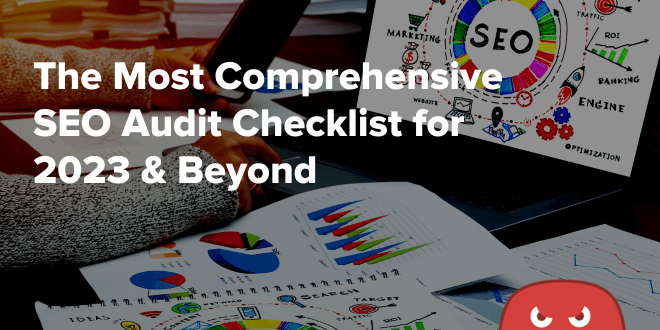



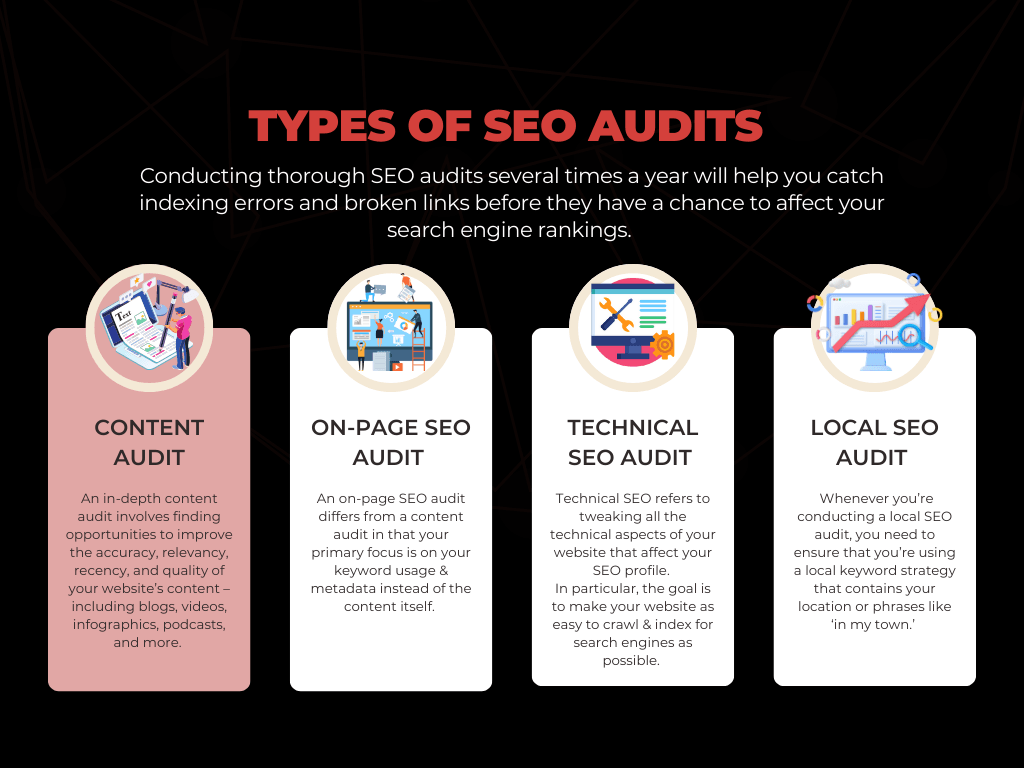
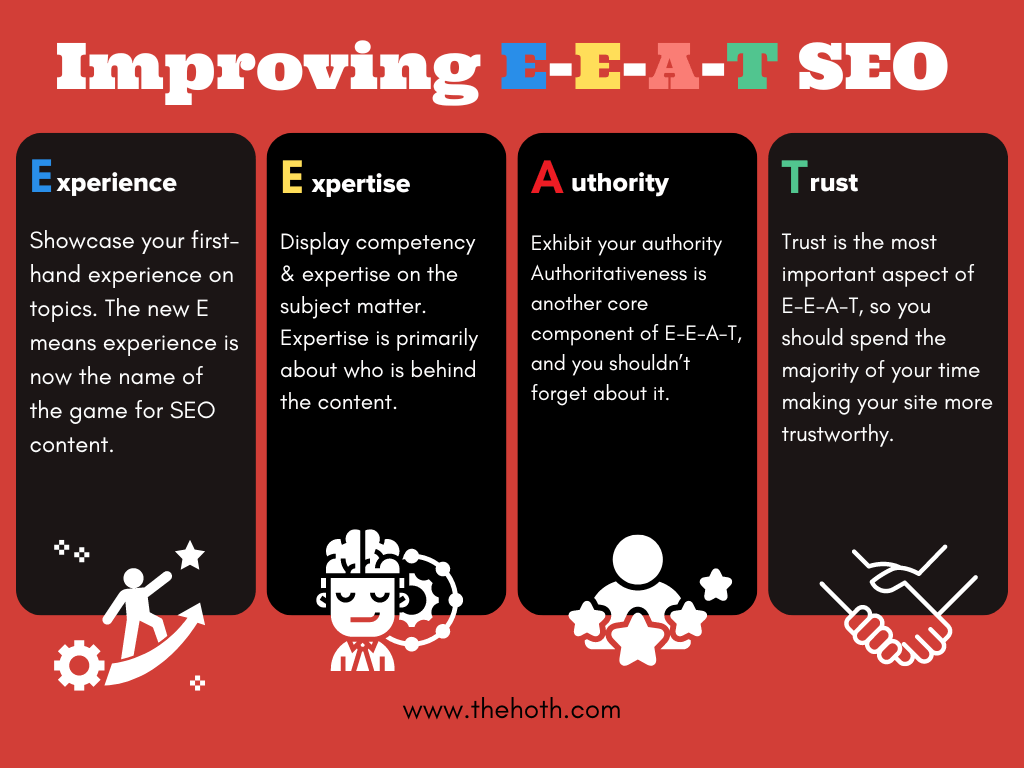
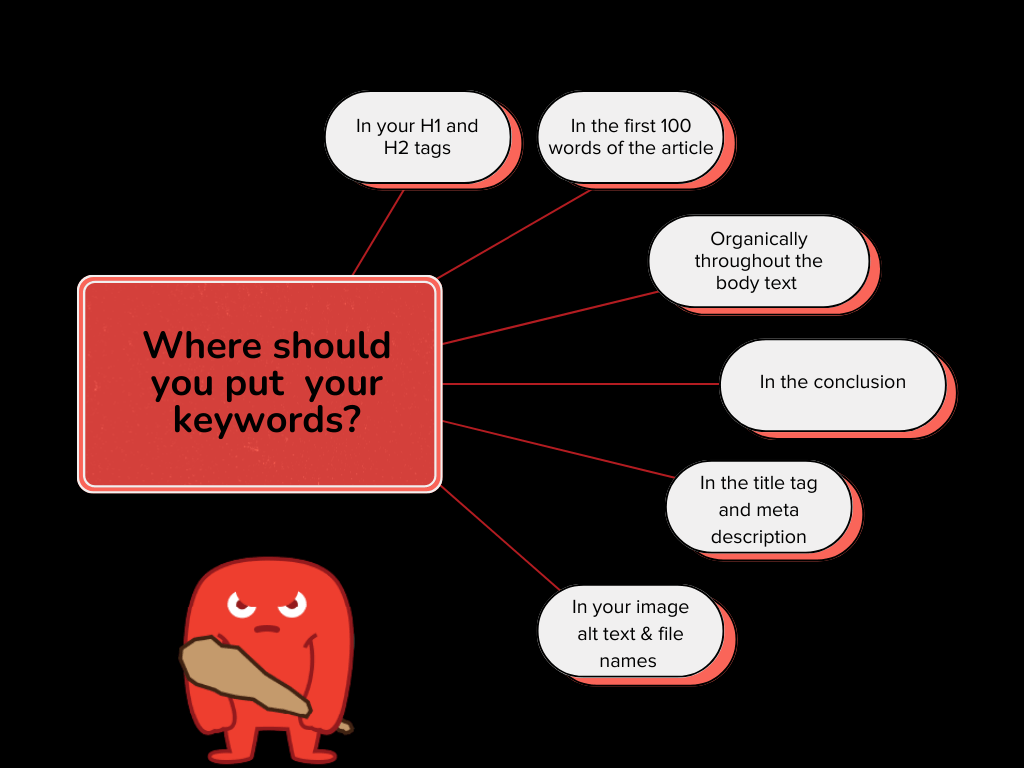
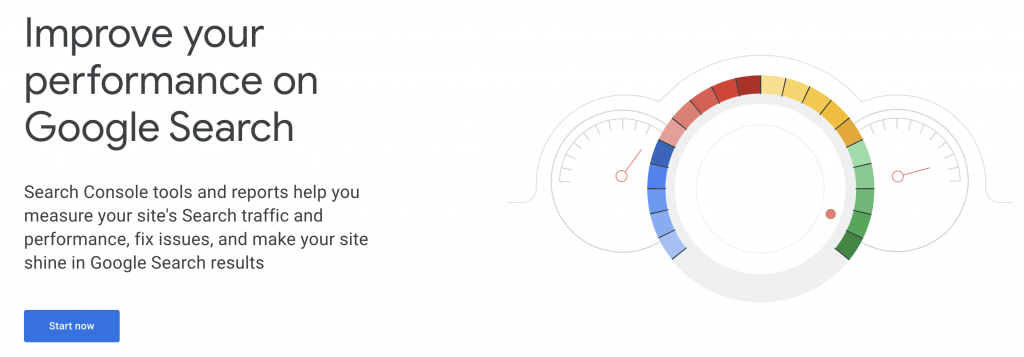
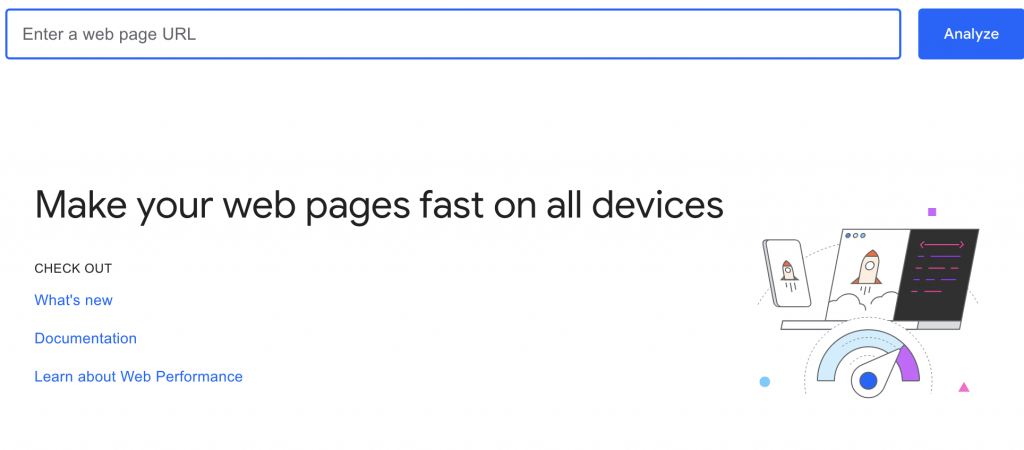
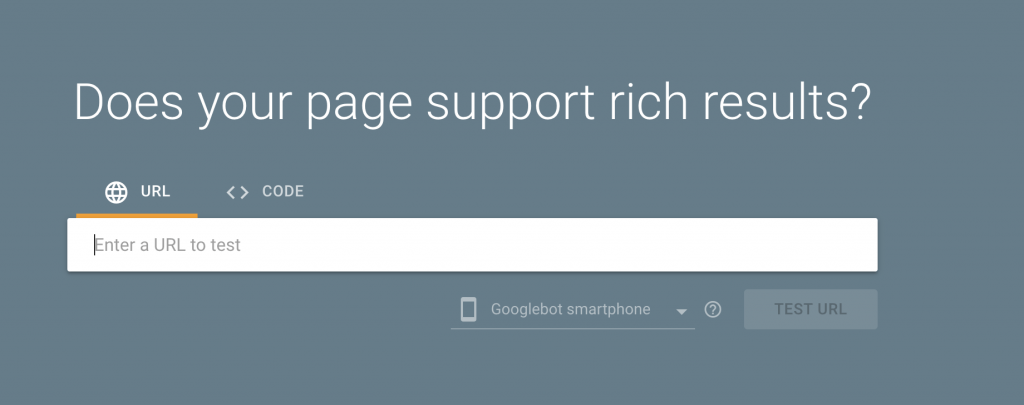

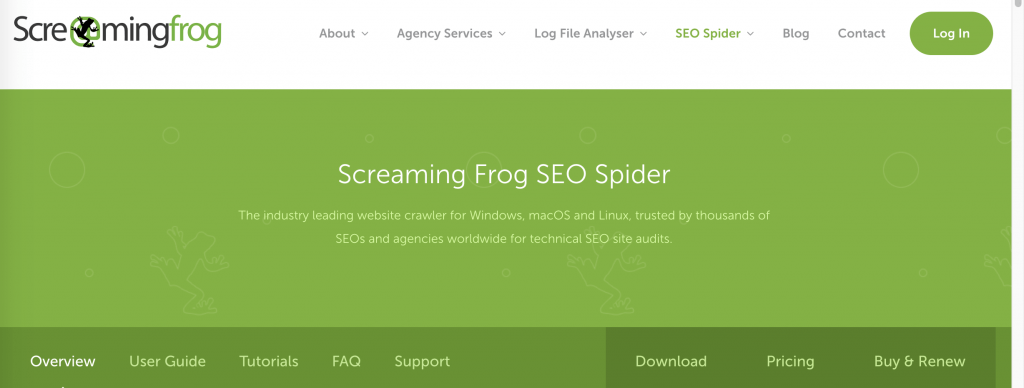
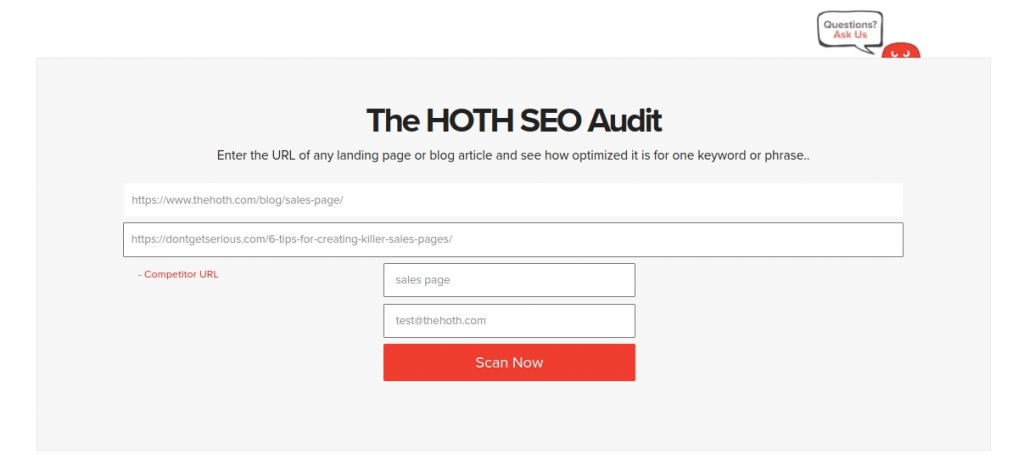
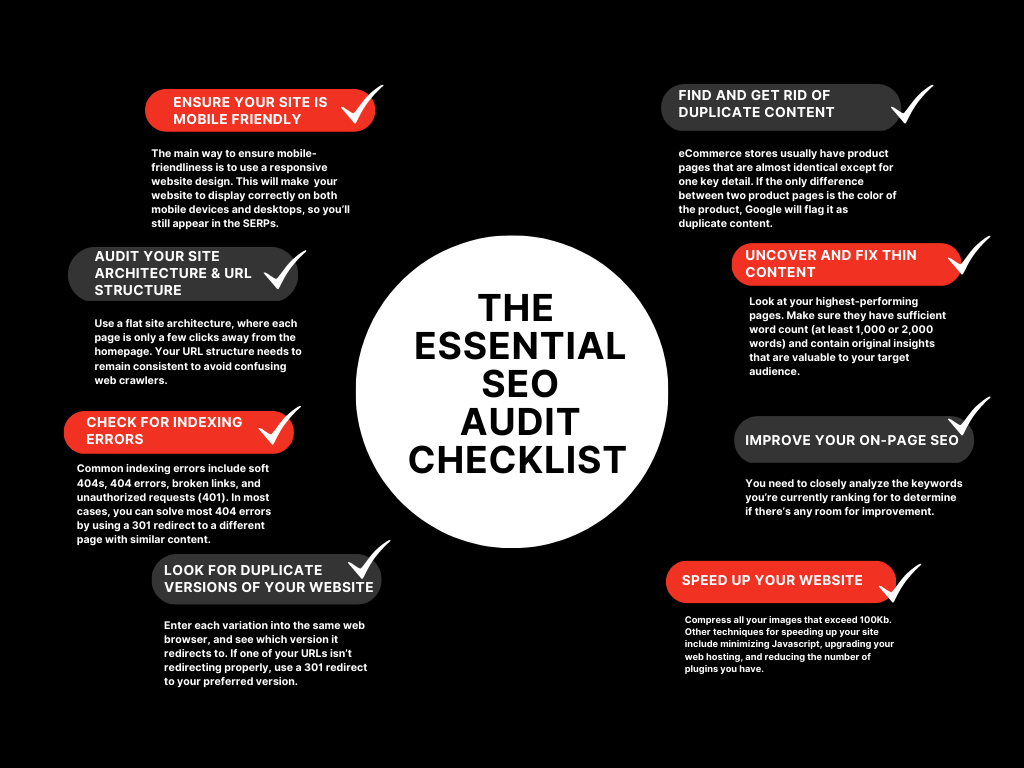


Thanks for sharing this SEO guide, we are always looking for a new SEO article which can help us in the ranking. And here we found something new and practical things that work for better SEO.
nice
great article
The best part of this article is that you have also mentioned the SEO audit tools, not just a checklist, that really made my SEO audit work easy. Thank you!!